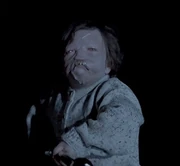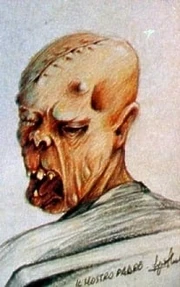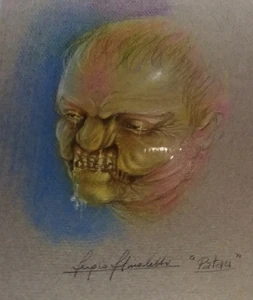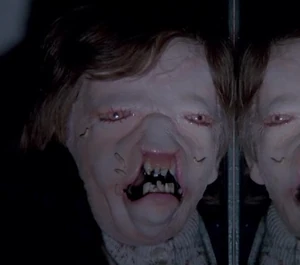| This article's content is marked as Mature The page contains mature content that may include coarse language, sexual references, and/or graphic violent images which may be disturbing to some. Mature pages are recommended for those who are 18 years of age and older. If you are 18 years or older or are comfortable with graphic material, you are free to view this page. Otherwise, you should close this page and view another page. |
| “ | When the murderer hides his victims, he likes to keep in physical contact with them. Conserving them. He is a psychopath. | „ |
| ~ Dr John McGregor. |
| “ | Go away, you scare me! I don't want you here. | „ |
| ~ Patau Brückner's son to Jennifer Corvino. |
Patau Brückner is the secondary antagonist of the 1985 Italian horror film Phenomena by Dario Argento.
The son of Frau Brückner and a mental asylum inmate, Patau is stunted and deformed, hating the sight of his own reflection and harboring necrophilic desires which push him to murder young girls and collect their bodies. He is enabled in his behavior by his mother, who works at the Swiss boarding school where many of his later victims study. Initially relying on any bladed tool at hand for his handiwork, such as scissors, Patau later commits his crimes with a cane sporting a detachable blade.
His makeup effects were designed by Sergio Stivaletti and he was portrayed by Davide Marotta.
Biography[]
Past[]
Fifteen years prior to the events of Phenomena, Frau Brückner, a Swiss psychiatrist, was raped by an inmate at a mental hospital in Basel. She relocated to a region known as the "Swiss Transylvania", where the local föhn winds were said to cause madness.
Brückner later gave birth to Patau, whom she kept chained up in a cottage. During his mother's absence, Patau broke free from his bonds and murdered Vera Brandt, a Danish tourist who had come across the cottage after missing her bus.
Patau kept her dismembered corpse in the cottage, which his mother subsequently sold and moved with him to a lakeside villa in Zurich, which contained a spacious basement where the rotting bodies of subsequent victims would be stored in a pit of water. Patau, a necrophile, would stay in close contact with the bodies and, as a result, find himself covered in sarcophagus fly larvae.
Present[]
In the eight months following Brandt's murder, Patau continues to claim victims, particularly young adolescent girls at the Richard Wagner Academy for Girls, where his mother now works as a secretary. One night, he kills student Gisela Sulzer, but this act is witnessed by Jennifer Corvino, an American student gifted with the power to communicate with insects.
Patau later kills French student Sophie, mistaking her for Jennifer on account of her wearing the same black sweater Jennifer wore on the night of the previous murder. In his haste to retreat, he leaves behind one of his gloves, which is covered in sarcophagus fly larvae.

Patau trying to kill Jennifer.
Fearing for her son's safety, Frau Brückner murders Dr. McGregor, an entomologist who thinks he can track Patau by exploiting the homing instinct of the fully grown larvae. She then convinces Jennifer, now intent on returning to the United States, to spend the night at her villa, where she will be collected by her father's agent.
Jennifer eventually encounters Patau in the villa's basement, cowering in a corner with his face covered. Unaware of his true nature, Jennifer attempts to comfort him and uncovers a nearby mirror, driving the killer into a rage. He chases Jennifer to a nearby motorboat and punctures its gastank with his cane during the struggle. Jennifer summons a swarm of flies to attack him, and they devour his face, causing him to fall into the lake.
The motorboat explodes after Jennifer tries to start its engine, and Patau attempts to drown her as she tries to resurface from the water. Failing this, Patau emerges for air and is engulfed in the rapidly spreading gasoline fire, finally dying with an inhuman scream.
Personality[]
Patau had a violent personality, fueled by his self-hatred and desire for the corpses of young girls. The mere sight of his own reflection triggered him seriously enough to prompt his mother to cover all mirrors in their villa, and seeing a girl would drive him to paroxysms of desire that were powerful enough for him to break out of chain manacles.
The ultimate root of his deviant behavior is never fully revealed, though it is implied to be a combination of his father's genetics, his mother's instability, and the influence of maddening föhn winds.
While the majority of his attacks were driven by necrophilia, his victims were carefully selected, and he would reject a corpse if it did not belong to the person he had intended to kill, as shown when he murdered Sophie, whom he mistook for Jennifer, and left her body.
Nevertheless, when not within visual distance of a girl or reflective surface, Patau acted more childlike, despite being in his mid-teens, apparently still playing with dolls and acting shy with strangers.
He had apparently little interest in personal hygiene, showing no concern over being covered in the maggots that caught on him from his contact with corpses.
Gallery[]
Trivia[]

Concept art for Patau's father by Sergio Stivaletti
- Special effects artist Sergio Stivaletti, who had previously studied medicine, drew inspiration from photographs he saw in medical texts of sufferers of Patau syndrome.[2]
- During the pre-production of Phenomena, Stivaletti drew sketches of Patau's father, incorporating a large scar on his head indicative of a past lobotomy, but this was rejected by Dario Argento, who considered it a superfluous addition to the plot.[3]
- For the insect swarming scene, Davide Marotta, who played Patau, was smeared in glucose and had around 40 million insects thrown at him.[4]
- Shortly after the release of Phenomena, Daria Nicolodi, who played Patau's mother, repudiated the film, calling it "reactionary" for portraying malformed people in a purely negative light and stated that she would refuse to work with Dario Argento in future.[5]
- Patau served as the main inspiration for Bobby Barrows, the first Scissorman, from the 1995 horror game Clock Tower.[6][7]
- In the Phenomena novelization by Lugi Cozzi, which was released as part of the 1997 horror anthology Terrore profondo, Patau is described as being the size of a ten-year-old child, but having the face of an old man with yellow teeth, small piggish eyes and covered in maggots.[8]
References[]
- ↑ While the English dub does not mention this directly, the word is used in the original Italian screenplay (È un necrofilo) and the movie's subsequent novelization.
- ↑ D'Amico, V., "Sergio Stivaletti: 'Il racconto dei racconti? Resta il dubbio, come sarebbe stato se lo avessi fatto io?'", Movieplayer.it, April 26, 2017
- ↑ Pulici, F. (2022), "Come ti materializzo il sogno: Davide Pulici intervista Sergio Stivaletti". In Linus, May 2022, pp. 79-81, ISBN 9788893889155
- ↑ Urciuolo, D., "Il talento non mente, la statura si. Intervista a Davide Marotta, bibliotecario “Arnaldo” nel nuovo film di Pieraccioni", Thefreak.it
- ↑ Caprara, F., "Il dopo Argento della Nicolodi", La Stampa, March 24, 1985
- ↑ Kemps, H., "Interview: Hifumi Kono of Nude Maker and Project Scissors/NightCry", Gaming.moe, February 16, 2015
- ↑ Elsam, S., "The making of Clock Tower: "The most important thing for me was the stillness"", Gamesradar.com, April 12, 2021
- ↑ Il bambino si voltò di scatto. Ma, mentre la sua figura era quella di un bambino di dieci anni, il volto non lo era affatto: era mostruoso, sembrava la faccia di un vecchio, ed era anche verminoso, con i denti giallastri, gli occhietti piccoli e porcini, schifosi, mentre tanti vermetti gli passeggiavano sul collo e sui vestiti.
Cozzi, L. (1997), "Phenomena". In Terrore profondo, Grandi Tascabili Economici Newton, p. 281, ISBN 88-8183-597-5




